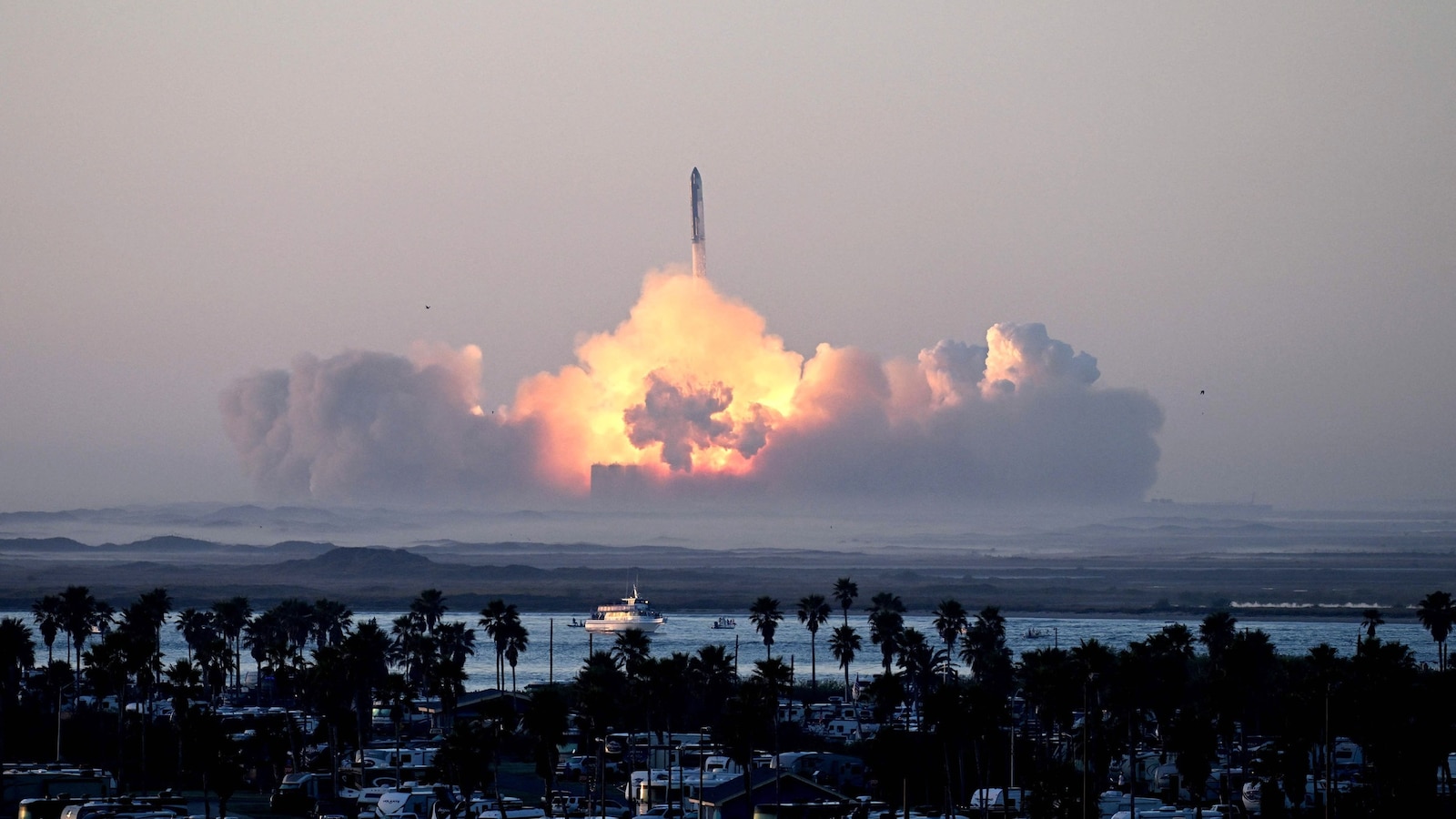Starship Launch: SpaceX's Texas Test Program & Next Flight

Table of Contents
SpaceX's Texas Test Facility & Infrastructure
The epicenter of Starship development is SpaceX's Boca Chica, Texas facility. This location, chosen for its relatively remote setting and access to the Gulf of Mexico for water landings, boasts extensive infrastructure specifically designed to support the gargantuan Starship. The scale of the operation is staggering, with a dedicated launch mount, massive integration hangars for assembling the spacecraft and booster, and sprawling propellant storage and transfer systems. The environmental impact of such a large-scale operation has naturally sparked debate and scrutiny, with SpaceX actively addressing concerns and implementing mitigation strategies. This commitment to environmental responsibility underscores the company's broader commitment to a sustainable future for space exploration.
- High Bay: A massive structure where Starship undergoes final assembly and integration with the Super Heavy booster.
- Launch Mount: A robust structure designed to withstand the immense forces generated during Starship launches, featuring advanced guidance and control systems.
- Propellant Storage & Transfer: A complex network of tanks and pipelines to safely store and transfer large quantities of cryogenic propellants – methane and liquid oxygen – necessary for Starship's powerful Raptor engines.
- Ongoing Upgrades: SpaceX continuously upgrades and expands the Boca Chica facilities, reflecting the iterative nature of the development process and the continuous push for efficiency and safety.
The Starship Test Program: A History of Launches and Lessons Learned
The Starship test program is a testament to SpaceX's iterative design philosophy. Numerous prototype vehicles, designated with the "SN" (Serial Number) prefix, have undergone a series of increasingly complex high-altitude flights. While some tests, like SN8's controlled descent and SN15's successful soft landing, showcased significant advancements, others, such as the explosions of SN9 and SN10, offered invaluable lessons. The detailed analysis of each flight's data—from successful landings to catastrophic failures—has proven crucial in refining the design, improving materials, and enhancing safety protocols for future Starship iterations. This continuous learning process has been fundamental to the program's progress.
- SN8-SN15: These test flights represent critical milestones, demonstrating incremental improvements in flight control, aerodynamic stability, and landing techniques.
- Failure Analysis: Meticulous investigations into flight failures have uncovered critical design flaws and operational vulnerabilities, allowing engineers to address them systematically.
- Iterative Design: The "fail fast, learn fast" approach has been instrumental in optimizing Starship's design, ensuring it can withstand the extreme stresses of atmospheric flight and landing.
Super Heavy Booster: The Power Behind Starship's Orbital Ambitions
The Super Heavy booster is a critical component of the Starship system, responsible for providing the immense thrust needed to propel Starship into orbit. Its power stems from a remarkable array of Raptor 2 engines, each generating immense power through the combustion of methane and liquid oxygen. This engine technology, coupled with the booster's massive propellant capacity, promises unprecedented launch capabilities. The ultimate goal is full reusability – recovering and reusing both the booster and the Starship itself—a key factor in lowering the cost of space travel and enabling frequent launches.
- Raptor 2 Engines: Hundreds of these powerful engines will power the Super Heavy booster, marking a significant technological advancement in rocket propulsion.
- Propellant Capacity: The immense propellant tanks will provide the fuel necessary for a powerful and sustained ascent into orbit.
- Reusability: The design incorporates advanced techniques for controlled descent and landing of the Super Heavy booster, a crucial element for cost-effective space access.
- Technological Challenges: Developing and integrating such a complex and powerful booster presents numerous challenges, but SpaceX has consistently demonstrated its ability to overcome them.
The Next Starship Launch: Predictions and Expectations
While SpaceX hasn't announced a concrete date for the next Starship launch, speculation based on regulatory approvals, testing progress, and SpaceX's statements points towards an imminent orbital test flight. This highly anticipated launch will be a pivotal moment, marking a significant step towards making Starship a fully operational spacecraft. The mission will likely focus on proving the integrated system's capability for orbital insertion, flight stability, and controlled re-entry. The eventual payload capacity of Starship promises to redefine the scope of space missions, opening doors for large-scale satellite deployments, lunar missions, and eventually, interplanetary travel.
- Launch Window: Although uncertain, several factors suggest a launch window within the near future.
- Mission Objectives: The primary objective is a successful orbital flight, demonstrating the functionality of the integrated Starship/Super Heavy system.
- Expected Payload: While details are scarce, the payload will likely include testing equipment and potentially demonstrate the vehicle's payload capacity.
- Future Development: A successful orbital launch will pave the way for future Starship missions, including lunar landings and potentially Mars colonization.
Conclusion
SpaceX's Starship program, with its innovative design and ambitious testing regime based in Texas, is pushing the boundaries of space exploration. The relentless progress at the Boca Chica facility, despite setbacks, highlights the program's potential to revolutionize access to space. The upcoming Starship launch represents a crucial milestone, promising to unlock a new era of space travel. Stay tuned for updates on the next Starship launch and follow SpaceX's progress as they strive to make humanity a multi-planetary species! Learn more about the Starship program and the ongoing Texas testing efforts. Follow SpaceX for the latest updates on the next Starship launch.

Featured Posts
-
 Pokemon Tcg Pocket Celestial Guardians A Card Performance Review
May 29, 2025
Pokemon Tcg Pocket Celestial Guardians A Card Performance Review
May 29, 2025 -
 Stranger Things Stars Deliver Back To Back Dystopian Sci Fi Movies
May 29, 2025
Stranger Things Stars Deliver Back To Back Dystopian Sci Fi Movies
May 29, 2025 -
 Piro I Nea Eisaggeleas Tis Oyasingkton Diorismeni Apo Ton Tramp
May 29, 2025
Piro I Nea Eisaggeleas Tis Oyasingkton Diorismeni Apo Ton Tramp
May 29, 2025 -
 Altfawl Alardny Hyal Atfaqyat Almyah Me Swrya Waqeyt Altwqeat Walyat Altnfydh
May 29, 2025
Altfawl Alardny Hyal Atfaqyat Almyah Me Swrya Waqeyt Altwqeat Walyat Altnfydh
May 29, 2025 -
 Gazze Den Kanser Hastasi Cocuklar Icin Uerduen Uen Insanlik Hareketi
May 29, 2025
Gazze Den Kanser Hastasi Cocuklar Icin Uerduen Uen Insanlik Hareketi
May 29, 2025
Latest Posts
-
 6 15
May 30, 2025
6 15
May 30, 2025 -
 Illegal Vehicle Registrations The Drain On Virginias Revenue From Maryland Drivers
May 30, 2025
Illegal Vehicle Registrations The Drain On Virginias Revenue From Maryland Drivers
May 30, 2025 -
 Virginia Loses Millions As Maryland Drivers Exploit Registration Loopholes
May 30, 2025
Virginia Loses Millions As Maryland Drivers Exploit Registration Loopholes
May 30, 2025 -
 Four Urgent Issues Facing British Tourists In Greece Foreign Office Warning
May 30, 2025
Four Urgent Issues Facing British Tourists In Greece Foreign Office Warning
May 30, 2025 -
 Greece Travel Alert Four Urgent Problems For British Citizens From The Foreign Office
May 30, 2025
Greece Travel Alert Four Urgent Problems For British Citizens From The Foreign Office
May 30, 2025
